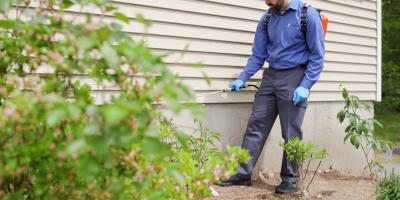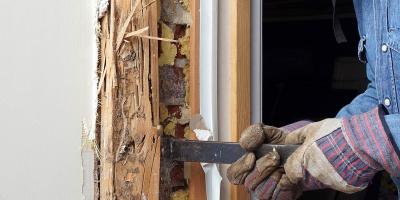Consequences of Poorly Managed Pest Infestations

Out of Sight, Out of Mind
When it comes to managing pest conditions, out of sight - out of mind is not a good thought process to maintain. The cryptic nature of destructive pests is to do exactly that; stay out of sight from potential predators and other threats to their survival as a species. Therefore, most pest infestations can suddenly creep up on consumers, and before homeowners or businesses take corrective action, they are overwhelmed by a well-established enemy.
Stinging Insect Nests:
Some pests, like wasps and hornets, seemingly boom overnight. These pests aggressively defend their nests by launching unrelenting attacks. And do so using their venomous stings and fast, agile flights.
Consequences of Stinging Insect Encounters:
For most of us, getting stung just requires first aid. However, some are hypersensitive to bee and wasp venom, and if stung, may require a visit to the local emergency room for critical care. More rarely, people die from as little as one sting from a bee, wasp, or hornet. Most people and pets can withstand a stinging insect attack, while painful, the bigger health risk can occur in fleeing these aggressive assailants leading to serious injuries from trips and falls. Unexpectedly dealing with stinging insects while working at heights around your home can be a life-changing or life-ending event.
Subterranean Termite Infestation:
Other destructive pests, like subterranean termites, are not intent on hurting people, but they are attracted to the shelters we call home as a food source. Termites are rarely out in the open for us to see, and literally keep themselves hidden behind the scenes inside wall voids, under ceilings, in basements, and crawlspaces. Additionally, termites are masters at camouflage and blend their foraging/exploratory mud tubes into the tight spaces between floor joists and sill plates. When they create surface damage to wood members, they quickly patch the openings with moist soil they carry from underground to keep their working spaces protected from predators and the elements.
Consequences of Subterranean Termite Infestations:
By the time an untrained homeowner or a qualified building expert finds termites in a structure, a fair amount of structural and cosmetic wood damage has most likely occurred. Termite reproductives swarm in spring, but only after a colony has been quietly damaging wood for five or more years. Termites are indiscriminate diners of cellulose materials, so not only is wood a preferred meal, but termites will also consume valuable documents, collectible books, rare art, antique furniture, custom wallpaper, or anything that contains cellulose. They also chew through other building materials like foamboard insulation, rubberized roofing materials, swimming pool liners, and drywall to seek moisture and potential cellulose materials on the other side. These damages add up to thousands, if not tens of thousands of dollars in damage per event.
Rodent Infestations:
Commensal rodents don’t mind sharing resources with people; however, they don’t like cohabitating with our permission or knowledge either. Mice and rats are nocturnal animals, so while you sleep, they search for resources to maintain their nests, nourish themselves and their young. In a very short matter of time, a mouse or two in the house can become an infestation as their numbers increase exponentially. Even though traps and baits were placed to manage what was believed to be a single rogue animal, these rodents have keen survival instincts to avoid danger including traps, predators (cats), and poisons.
Consequences of Rodent Infestations:
As soon as rodents enter a home or building, they begin to mark their territory. Marking their territory involves bodily materials like body grease (sebum), urine, and feces. Rodent infestations rarely involve a single animal, and in a short amount of time, mice and rats will spread their germ-laden deposits everywhere including on food handling surfaces, pantries, ovens, refrigerators, walls, ceilings, carpets…everywhere! It is detrimental to one’s health to eat foods that have been contaminated by rodents.
Aside from their destruction of food, mice, rats, and squirrels constantly gnaw on most structural materials including wires, wood, plastic pipes/tubing, insulation, and siding causing damage to these materials. Home and commercial building fires have been attributed to rodents gnawing on live wires. Also, many wire harnesses in cars and trucks have been destroyed from mice gnawing on the wires costing consumers thousands of dollars in uninsured damages.
Filling the Void:
Consumers often question why they need a 365 pest protection program, and the simple answer is that a home or structure is under constant pressure from the outside world. We have built our shelters and businesses to protect us from natural elements including heat, cold, rain, snow, wind, ice, and pests of all sorts. Homes and commercial structures are typically well-built to protect people and property from weather conditions, but rarely are they built well enough to keep pests out. All pests, whether insects, spiders, or rodents require food, water, and shelter to survive; the very same things we need, also known as the ‘triangle of life’.
In their pursuit of the triangle of life, pests are constantly searching for the resources that enable their populations to grow and thrive. Our homes and commercial buildings are perfect environments for pests. Whenever one pest population is eliminated, there are many others hoping to fill the void. This means that homes and businesses must be constantly monitored by trained pest professionals to prevent the next pest infestation.
At JP Pest Services, our professional service specialists are very knowledgeable and expertly trained to conduct site inspections that identify pest activity and avert future problems. Our goal, through an Integrated Pest Management (IPM) approach, is to prevent the next infestation. The moment you let your guard down, pest invaders seeking food, water, and shelter will fill the void!



